Your Cart is Empty
Menu
-
- Shop by Type
- End of Line Sale Items
- New In
- Viking Gifts Under $30
- Hand Forged Axes
- Silver Viking Jewelry
- Stainless Steel Jewelry
- Cremation Jewelry
- Necklaces and Pendants
- Hand Carved Wooden Pendants
- Kings Chains
- Viking Drinking Horns
- Pendant Chains
- Rings
- Bracelets
- Earrings
- Beard Beads and Beard Rings
- Collectables
- Ceramic Mugs
- Street Wear
- Horn Jewelry
- Bronze and Pewter Jewelry
- Shop by Theme
- Viking Axe
- Celtic Jewelry
- Dragon or Serpent
- Viking Raven
- Wolf / Fenrir
- Rune Jewelry
- Odin Jewelry
- Ram / Goat
- Shieldmaidens / Lagertha
- Sword, Spear or Arrow
- Thor's Hammer / Mjolnir
- Tree of Life / Yggdrasil
- Helm of Awe / Aegishjalmur
- Triquetra or Triskelion
- Valknut / Knot of Slain
- Vegvisir / Viking Compass
- Veles / Bear
- Blogs
- Help
-
- Login

Viking Art Styles - A Historical Guide

Despite often being portrayed as blood-thirsty pillagers, Vikings, or more accurately Norsemen, were fine craftsmen who loved to decorate wood, metal, stone, bone, ivory and textiles with elaborate designs. Weapons, jewelry, ships, religious artefacts and everyday domestic items were all carved with care and passion with animals, both real and mythical, and abstract designs being the most common themes.
Imagery was created to communicate ideas about social relations, religious beliefs, and to recall a mythical past. Although many objects served pagan intentions, Christian themes began to creep into designs in later years as expansion and increasing exposure to differing cultures and new ideas filtered into the region.
Over time, styles and designs changed and we now categorize Viking art into six distinctive but overlapping periods, each named after the geographical area where important archaeological finds were made.
Oseberg Style
Taking its name from the Oseberg Ship grave discovered in 1904 in Norway but also known as 'Style E', this period lasted from the late 8th century to the late 9th century and was characterized by tightly interlaced, dense carvings of animals with long bodies and small heads, often with bulging eyes.
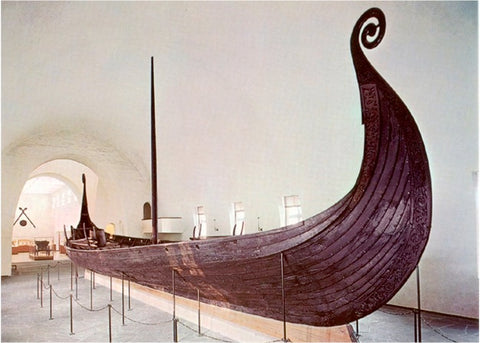
The Oseberg Viking Ship
Another theme of this period was the so-called 'Gripping Beasts' where animals were depicted with their claws gripping on to nearby objects such as the image below.
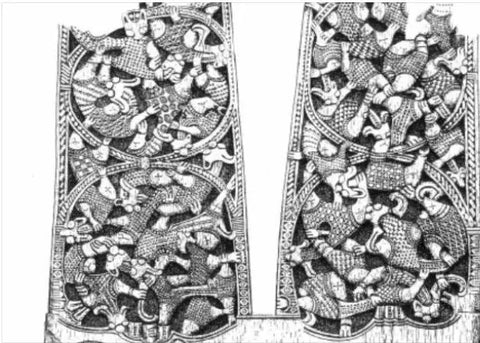
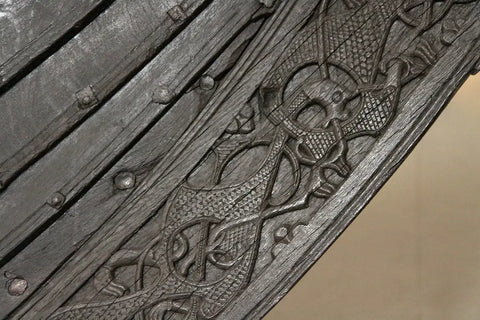
Gripping Beast Detail from the Oseberg Viking Ship
Borre Style
The Borre period was the most widespread of all the Scandinavian styles and ran from approximately the mid 9th century to the late 10th century and overlapped both the Oseberg period that preceded it and the Jelling style that followed. As Vikings travelled both East and West during this time, this style travelled with them and has been found in archaeological remains in both Britain and the Baltic regions.
The style was named after a set of gilt-bronze harness mounts found in a ship burial in Borre, Norway and whilst this stye still has the gripping beasts present, the Borre style focuses more on a single, contorted beast with triangular head and cat-like face.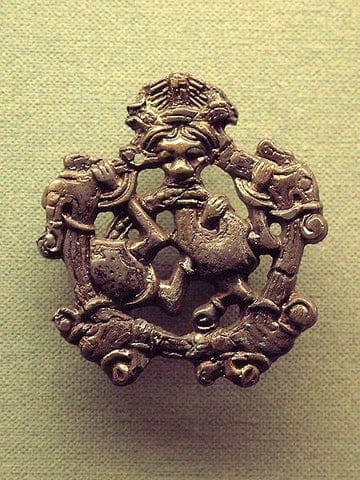
Viking Brooch in the Borre Style
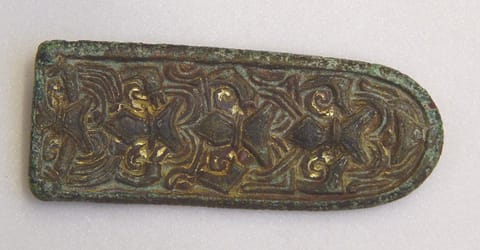
Another Borre style brooch from the British Museum
Another specific characteristic of this style is the 'ring chain' pattern which combines ribbon shapes to create a continuous band as seen on this golden spur from Verne Kloster in Norway.
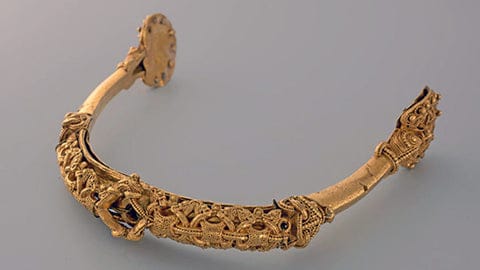
Jelling Style
The Jelling style appeared at the start of the 10th century and lasted for approximately 50-75 years before gradually developing into the Mammen style. This phase was characterized by stylistic S-shaped, intertwined animals with beaded or patterned bodies that were often shown with their heads in profile and often with large, round eyes and mitten shaped legs.
The Jelling (or Jellinge) style was named after a cast silver cup discovered in a royal burial mound in Jelling, Denmark.
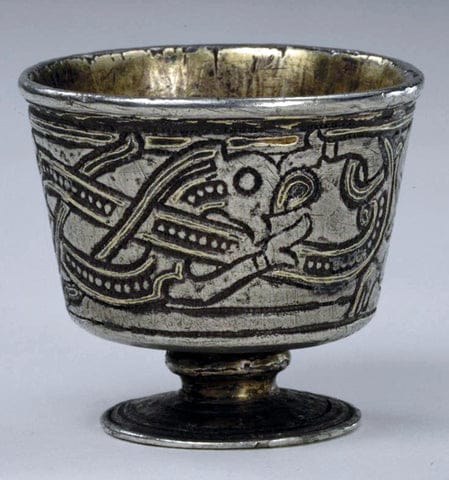
The Jelling Cup
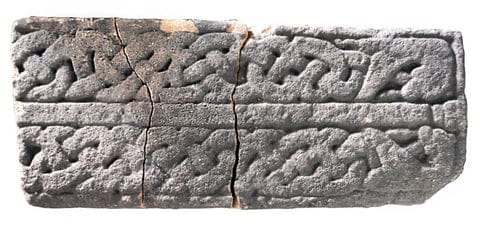
Part of a gravestone with Jelling style elements found in York Minster cemetery, UK.
Mammen Style
Starting in the mid tenth century and lasting for approximately fifty years before gradually merging with the Ringerike style, the Mammen style's predominant features were sinewy, lion, bird and serpent-like creatures intertwined in both themselves and what could be taken for either snakes or foliage.
The Mammen style was named after a small axe head found in a grave site in Mammen, Denmark. The axe head has a stylized bird-like creature with spiral hip joints intertwined with winding tendrils on one side, and what could be a Yggdrasil or tree-like structure on the other.
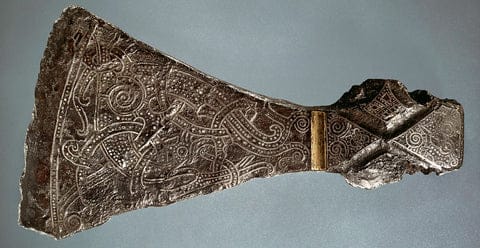
The Mammen Axe Head - original above and an artistic impression of the detail below from Mette, Iversen, Ulf Näsman, and Jens Vellev, Mammen. Grav, kunst og samfund i vikingetid (1991).
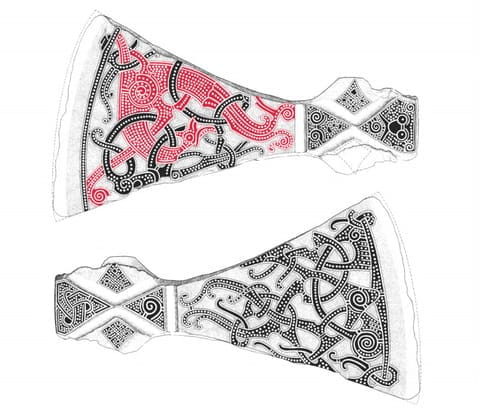
The axe itself was carved and then inlaid with silver, a clear indication that this was not an axe that was intended to be used but was a ceremonial object owned by a wealthy Norseman.
Another great example of Mammen-style art is the Jelling Stone (from Jelling in Denmark) which features a central lion or griffin intertwined in what appears to be a snake.
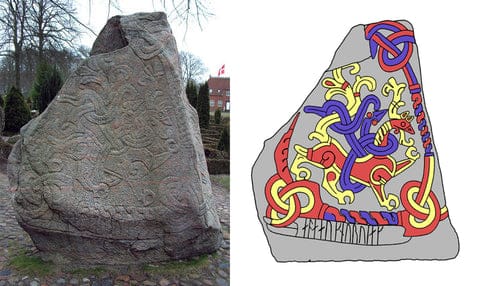
The Jelling Stone, Denmark
The style of the piece suggests there was a heavy English influence to the design (it is similar to the Anglo-Saxon Winchester style). The central lion or griffin was not a native Scandinavian theme and suggests a more Christian influence as the religious conversion of Denmark gradually took place.
Ringerike Style
The Ringerike style slowly emerged from the Mammen style around 990 CE and remained popular until the middle of the eleventh century.
Named after memorial stones found around Ringerike, just north of Oslo in Norway, this style shared a lot of the themes common in the Mammen style that proceeded it - continued use of large animal motifs including snakes, lions, griffins and other ribbon animals along with plant and foliage patterns. However, instead of the more free form shapes of the Mammen style, the Ringerike style was characterized by designs that were more balanced, taught and geometric.
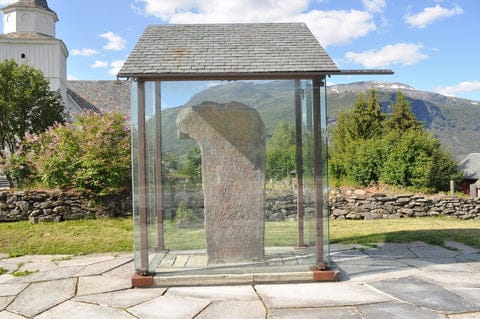
The Vang Stone - One of the most famous of the Ringerike Stones
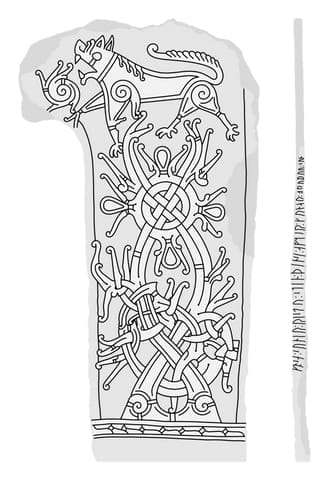
Vang Stone Detail - From Artist Jonas Lau Markussen
As Christianity took increasing hold throughout Scandinavia during this period, the number of items buried as grave goods decreased meaning that Ringerike era decorations were more likely to be found adorning items such as weapons and architecture such as this weathervane.
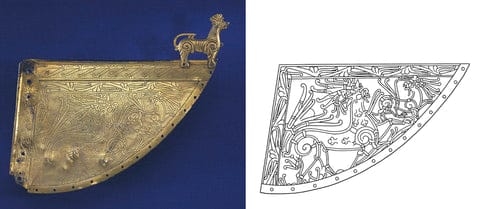
Ringerike style weathervane - Kulturhistorisk Museum, Norway
The Urnes Style
Prominent between 1040 CE and 1100 CE, the Urnes Style was the final Norse art style featuring stylized animals. Named after carved wooden panels on the stave church at Urnes in western Norway, this style is characterized by asymmetric designs of tightly intertwining, twisting animals, snakes and tendrils. The principle animal remains the great four-legged beast that by now resembles something between a deer and a greyhound with a long neck and slim head.
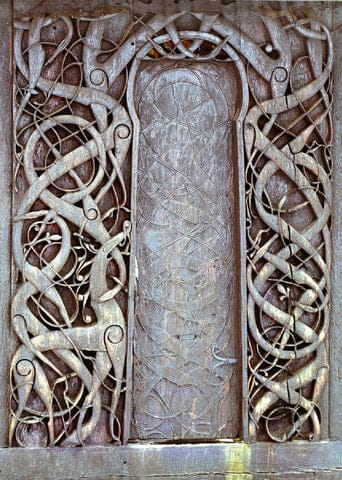
Wooden panel from Urnes stave church
The largest collection of objects in this style were the runestones discovered in Uppland in Sweden (an alternative name for the Urnes style is the 'runestone style').
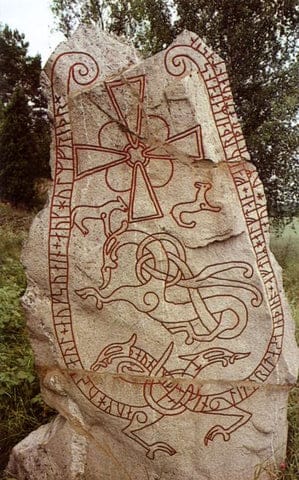
Runestone from Uppland, Sweden
As the Vikings traveled further afield from their heartlands in Scandinavia, the style traveled with them and Urnes style objects have been found in England, Ireland and across the Baltic states.
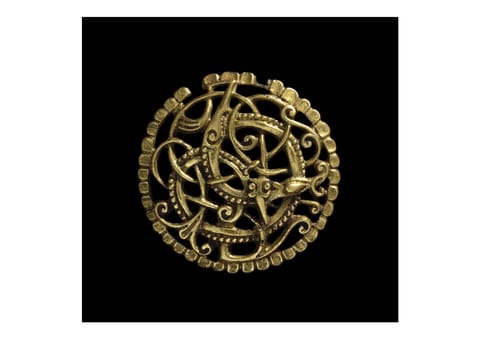
Urnes style brooch found in Pitney, England. Now in the British Museum
